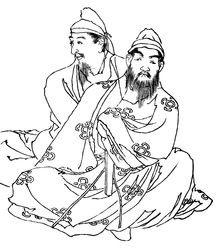Fujiwara no Maro (藤原 麻呂, 695 – August 17, 737) was a Japanese statesman, courtier, and politician during the Nara period.[1] Maro established the Kyōke branch of the Fujiwara clan.
Fujiwara no Maro | |
|---|---|
 Fujiwara no Muchimaro and Fujiwara no Maro, from Zenken Kojitsu | |
| Native name | 藤原 麻呂 |
| Other names | Banri (万里) |
| Born | 695 |
| Died | 17 August 737 |
| Nationality | Japanese |
| Spouse(s) | Many |
| Issue | Fujiwara no Momoyoshi Fujiwara no Hamanari Fujiwara no Tsunatori Fujiwara no Katsuhito |
| Father | Fujiwara no Fuhito |
| Mother | Ioe no Iratsume |
| Notes | |
| Relatives Fujiwara no Fusasaki (brother) Fujiwara no Muchimaro (brother) Fujiwara no Miyako (brother) Fujiwara no Nagako (brother) Fujiwara no Umakai (brother) Empress Kōmyō (sister) Fujiwara no Tabino (brother) | |
Career
editMaro was a minister (sakyō no dayū) during the reign of Emperor Shōmu.[2]
- 737 (Tenpyō 9, 7th month): Maro died at age 43.[3] The 735–737 Japanese smallpox epidemic caused the death of Maro and all three of his brothers, all in the same year.[4]
Genealogy
editThis member of the Fujiwara clan was the son of Fujiwara no Fuhito.[1] Maro had three brothers: Fusasaki, Muchimaro and Umakai. The four brothers are known for having established the "four houses" of the Fujiwara.[5]
- Father: Fujiwara no Fuhito (藤原不比等, 659–720)
- Mother: Ioe-no-iratsume (五百重娘, ?–?), former wife of Emperor Tenmu.
- Wife: Lady from the Taima clan (当麻氏)
- Daughter: Fujiwara no Momoyoshi (藤原百能, 720–782)
- Wife: name unknown, daughter of Inaba no Kimame (稲葉気豆)
- 1st son: Fujiwara no Hamanari (藤原浜成, 724–790)
- Children with unknown mother:
- Son: Fujiwara no Tsunatora (藤原綱執)
- Son: Fujiwara no Katsuhito (藤原勝人)
- Possible wife: Ōtomo no Sakanoue-no-iratsume (大伴坂上郎女), daughter of Ōtomo no Yasumaro (大伴安麻呂).
- Wife: Lady from the Taima clan (当麻氏)
Notes
edit- ^ a b Nussbaum, Louis-Frédéric. (2005). "Fujiwara no Umakai" in Japan Encyclopedia, p. 205, p. 205, at Google Books; Brinkley, Frank. (1915). A History of the Japanese People from the Earliest Times to the End of the Meiji Era, p. 203., p. 203, at Google Books
- ^ Titsingh, Isaac. (1834). Annales des empereurs du japon, p. 70, p. 70, at Google Books; see "Fousiwara-no Maro", pre-Hepburn romanization
- ^ Titsingh,p. 69, p. 69, at Google Books
- ^ Brinkley, p. 190., p. 190, at Google Books
- ^ Brinkley, p. 203., p. 203, at Google Books; excerpt, "Muchimaro's home, being in the south (nan) of the capital, was called Nan-ke; Fusazaki's, being in the north (hoku), was termed Hoku-ke; Umakai's was spoken of as Shiki-ke, since he presided over the Department of Ceremonies (shiki), and Maro's went by the name of Kyō-ke, this term also having reference to his office."
References
edit- Brinkley, Frank and Dairoku Kikuchi. (1915). A History of the Japanese People from the Earliest Times to the End of the Meiji Era. New York: Encyclopædia Britannica. OCLC 413099
- Nussbaum, Louis-Frédéric and Käthe Roth. (2005). Japan encyclopedia. Cambridge: Harvard University Press. ISBN 978-0-674-01753-5; OCLC 58053128
- Titsingh, Isaac. (1834). Annales des empereurs du Japon (Nihon Odai Ichiran). Paris: Royal Asiatic Society, Oriental Translation Fund of Great Britain and Ireland. OCLC 5850691
External links
edit- 水垣 久. 藤原麻呂 (in Japanese). Retrieved 2007-09-22.